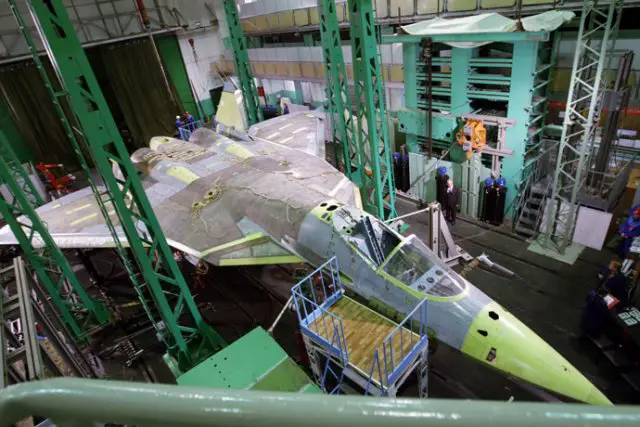Breaking news
UAC now gearing up for T-50 PAK FA low-rate initial production batch.
| 2016
| a | |||
|
|
|||
|
World Defense & Security Industry News - United Aircraft Company
|
|||
|
|
|||
|
UAC now gearing up for T-50 PAK FA low-rate initial production batch
|
|||
|
The United Aircraft Corporation (UAC) is gearing up for the manufacture of a low-rate initial production (LRIP) batch of T-50 fifth-generation fighters (Russian acronym - PAKFA) for the delivery to the Russian Aerospace Force (RusAF), according to the Izvestia daily.
|
|||
|
|
|||
 A T-50 PAK FA 5th-gen fighter being assembled at the Komsomolsk-on-Amur Aircraft Plant A T-50 PAK FA 5th-gen fighter being assembled at the Komsomolsk-on-Amur Aircraft Plant(Credit: RIA Novosti/Alexei Druzhinin) |
|||
|
|
|||
|
The eighth flying prototype almost meeting the military’s requirements to the fifth-generation fighter’s characteristics will take to the skies in Komsomolsk-on-Amur on June 20. Unlike the previous prototypes, the eighth one is fully outfitted with the equipment and systems spelt out by the requirements specification for the future fighter. With the advent of the eighth prototype, the configuration of the T-50 as a combat aircraft has been finalized, and the type is ready for the production for the RusAF.
At present, four more T-50s are sitting in the shops of the Komsomolsk-on-Amur Aircraft Plant in various stages of assembly. Aircraft No. 9 will join the trials in September. The 10th and 11th airframes are in their assembly jigs, one with its fuselage mated and the other with its wing center section assembled. Both will have started their flight tests before the end of the year. In the fall, UAC will be prepared for signing a LRIP batch contract with the Defense Ministry. Center for Analysis of Strategies and Technologies Director Ruslan Pukhov says a LRIP batch is at least 12 aircraft, i.e. a squadron’s worth of planes in addition to the prototypes being tested now. In other words, brand-new combat aircraft fully complaint with the requirements specification will be built in 2017 for the RusAF and subjected to operational evaluation, after which more aircraft may be ordered. Pukhov added that the T-50 would not become a mass-produced fighter for a while. It is being positioned as the primary rival of the USAF’s F-22 Raptor. The United States had bought 187 Raptors and terminated the program. Russia’s T-50 and its development program is less expensive by an order of magnitude, but Deputy Defense Minister for Armament Yuri Borisov has said that the RusAF might acquire fewer fifth-generation fighters that planned under the 2020 State Armament Program. The military wants to buy 12 fighters for now and, after the type’s service entry, will decide on the number it can afford. The refining of the plane after its service entry will take years. Suffice it to say that there have been so many design and avionics modifications between the Su-27’s (NATO reporting name: Flanker) T-10 prototype made in 1977 and the final version that only the latest variant, the Su-35S (Flanker-E) included into the inventory a year before last, may be regarded as the final one. In all probability, the T-50 is facing the same future. The fifth-generation engine, known as Product 30 or ‘second-phase engine’ today, is in development now. The 117S engine equipping the Su-35S will power the production-standard T-50. Although the 117S provides the required total thrust sufficient for supercruise, it does not meet the fifth-generation engine’s thrust-to-weight and fuel consumption standards. The complexity of debugging the second-phase engine necessitates rather numerous bench and flight tests, which will have an impact on the T-50’s development schedule. According to estimates, the T-50 fighter fleet will get the second-phase engine in 2025-2027 at the earliest. Hence, the T-50 will not turn into a true fifth-generation fighter until then. Pukhov believes that preemptive tactics should be pursued now by not only developing the T-50 with our strategic partner in military-technical cooperation, India, under the Fifth Generation Fighter Aircraft (FGFA) Program, but also by offering the fighter to Algeria and Vietnam. The two countries have pursued independent military-technical policies and can afford up-to-date armament. The T-50’s development and production costs may be slashed through exporting the type, according to the Izvestia daily. |
|||
|
|
|||
|
© Copyright 2015 TASS. All rights reserved. This material may not be published, broadcast, rewritten or redistributed.
|
|||



















